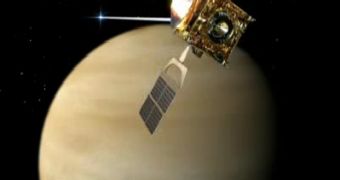Measurements conducted with ESA's Venus Express spacecraft reveal that Venus contains variable quantities of sulphur dioxide gas in the upper layers of the atmosphere, which may be evidence that Venus still has active volcanoes on its surface or some other unknown mechanism is producing this effect. Sulphur dioxide released into the Earth's atmosphere, generally remains there for very short periods of time, because it reacts with the planet surface.
This could also be available for Venus, however the reactions are believed to be much slower and may take as long as 20 million years. "Volcanoes are a key part of a climate system," because they can release gases such as sulphur dioxide, says Venus Express Interdisciplinary Scientist from Oxford University, Fred Taylor.
Because of these possible long reaction times between sulphur dioxide and the Venusian surface, scientists cannot accurately determine whether it comes from a volcanic eruption taking place in real-time or from one that occurred more than 10 million years into the past. Now, the Venus Express spacecraft revealed sulphur dioxide clouds experiencing rapid variations, sign that there may still be active volcanoes on the surface.
The Spectroscopy for Investigation of Characteristics of the Atmosphere of Venus instrument, or SPICAV for short, works by measuring the light of background stars absorbed into the atmosphere of Earth's evil twin. Through this technique, the instrument is able to make spectroscopic investigations in order to determine the composition of the atmosphere. During observations, the Venus Express probe revealed that in a matter of only a few days the sulphur dioxide concentrations in a region of Venus' atmosphere, located 70-90 kilometers above the surface, suffered a decrease by two-thirds.
"I am very skeptical about the volcanic hypothesis. However, I must admit that we don't understand yet why there is so much SO2 at high altitudes, where it should be destroyed rapidly by solar light, and why it is varying so wildly," said Jean-Loup Bertaux, Service d'Aeronomie du CNRS and Principal Investigator for SPICAV.
The second spectrometer on-board Venus Express, namely the Visible and Infrared Thermal Imaging Spectrometer, conducting investigation in infrared, showed that "sulphur dioxide at an altitude of 35-40 kilometers, reveals no change larger than 40 percent on a global scale over the last two years," says VIRTIS co-Principal Investigator, Giuseppe Piccioni.
Anyway, the dense atmosphere of Venus, measuring about 100 kilometers, makes accurate investigation almost impossible. This basically means that there is no way to know whether the sulphur dioxide cloud is determined by volcanic activity or not. However, the Venus Express may use two techniques in order to determine whether or not volcanic activity is to blame.
One would be the detection of a large cloud of gas which could only be determined by volcanoes. The second would involve looking for thermal variations indicating the presence of fresh lava flows. "No thermal anomaly has been detected so far," said Pierre Drossart of Observatoire de Paris and co-Principal Investigator on VIRTIS.

 14 DAY TRIAL //
14 DAY TRIAL //